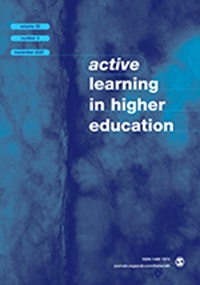Multitasking in the classroom: Testing an educational intervention as a method of reducing multitasking
IF 3.2
1区 教育学
Q1 EDUCATION & EDUCATIONAL RESEARCH
引用次数: 11
Abstract
Increasingly, students engage in multitasking during lecture by shifting their attention between class material and irrelevant information from texts and webpages. It is well established that this divided attention impairs memory and learning. Less is known about how to correct the problem. This study used an educational intervention in the form of a PowerPoint presentation that informed students in the experimental condition about the deleterious effects of multitasking. Students were randomly assigned to the experimental condition, the placebo condition (a slideshow about sleep), or no intervention. Participants self-reported the percentage of the time they multitasked in class and paid attention at two time points, baseline (before the intervention), and in a second lab visit 3 weeks later. The experimental intervention did not reduce student multitasking or increase student attention, relative to the other conditions. Supplementary research questions examined students’ beliefs about multitasking, finding that most thought it decreased their grades. The correlations between grade point average, stress, and boredom proneness, on one hand, and baseline attention and multitasking in class, on the other, were also inspected, revealing that students with higher grade point average pay more attention in class and multitask less. Suggestions for future research to reduce multitasking are made, including having students engage in multitasking to observe the effect on their memory retention.课堂上的多任务处理:测试一种教育干预作为减少多任务处理的方法
越来越多的学生在课堂上进行多任务处理,他们的注意力在课堂材料和文本和网页上的无关信息之间转移。众所周知,这种注意力分散会损害记忆力和学习能力。人们对如何纠正这个问题知之甚少。这项研究采用了一种教育干预的形式,即幻灯片演示,告诉实验条件下的学生多任务处理的有害影响。学生们被随机分配到实验组、安慰剂组(播放有关睡眠的幻灯片)和无干预组。参与者在基线(干预前)和3周后的第二次实验室访问的两个时间点,自我报告他们在课堂上多任务处理和集中注意力的时间百分比。与其他条件相比,实验干预并没有减少学生的多任务处理或增加学生的注意力。补充研究问题调查了学生对多任务处理的看法,发现大多数人认为这会降低他们的成绩。研究人员还考察了平均分、压力和无聊倾向与课堂上的基本注意力和多任务处理之间的关系,发现平均分较高的学生在课堂上注意力更集中,多任务处理更少。对未来减少多任务处理的研究提出了建议,包括让学生参与多任务处理来观察对他们记忆保持的影响。
本文章由计算机程序翻译,如有差异,请以英文原文为准。
求助全文
约1分钟内获得全文
求助全文
来源期刊

Active Learning in Higher Education
EDUCATION & EDUCATIONAL RESEARCH-
CiteScore
13.20
自引率
12.00%
发文量
31
期刊介绍:
Active Learning in Higher Education is an international, refereed publication for all those who teach and support learning in higher education (HE) and those who undertake or use research into effective learning, teaching and assessment in universities and colleges. The journal is devoted to publishing accounts of research covering all aspects of learning and teaching concerning adults in higher education. Non-discipline specific and non-context/country specific in nature, it comprises accounts of research across all areas of the curriculum; accounts which are relevant to faculty and others involved in learning and teaching in all disciplines, in all countries.
 求助内容:
求助内容: 应助结果提醒方式:
应助结果提醒方式:


